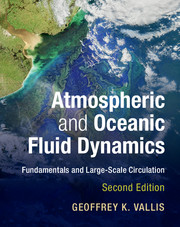Book contents
- Frontmatter
- Dedication
- Contents
- Preface
- Notation
- PART I FUNDAMENTALS OF GEOPHYSICAL FLUID DYNAMICS
- PART II WAVES, INSTABILITIES AND TURBULENCE
- PART III LARGE-SCALE ATMOSPHERIC CIRCULATION
- PART IV LARGE-SCALE OCEANIC CIRCULATION
- 19 Wind-Driven Gyres
- 20 Structure of the Upper Ocean
- 21 The Meridional Overturning Circulation and the acc
- 22 Equatorial Circulation and El Niño
- References
- Index
19 - Wind-Driven Gyres
from PART IV - LARGE-SCALE OCEANIC CIRCULATION
Published online by Cambridge University Press: 09 June 2017
- Frontmatter
- Dedication
- Contents
- Preface
- Notation
- PART I FUNDAMENTALS OF GEOPHYSICAL FLUID DYNAMICS
- PART II WAVES, INSTABILITIES AND TURBULENCE
- PART III LARGE-SCALE ATMOSPHERIC CIRCULATION
- PART IV LARGE-SCALE OCEANIC CIRCULATION
- 19 Wind-Driven Gyres
- 20 Structure of the Upper Ocean
- 21 The Meridional Overturning Circulation and the acc
- 22 Equatorial Circulation and El Niño
- References
- Index
Summary
UNDERSTANDING THE CIRCULATION OF THE OCEAN involves a combination of observations, comprehensive numerical modelling, and more conceptual modelling or theory. All are essential, but in this chapter and the ones following our emphasis is on the last of the triad. Its (continuing) role is not to explain every feature of the observed ocean circulation, nor to necessarily describe details best left to numerical simulations. Rather, it is to provide a conceptual and theoretical framework for understanding the circulation of the ocean, for interpreting observations and suggesting how new observations may best be made, and to aid the development and interpretation of numerical models.
The aspect of the ocean that most affects the climate is the sea-surface temperature (sst), as illustrated in Fig. 19.1, and aside from the expected latitudinal variation there is significant zonal variation too — the western tropical Pacific is particularly warm, and the western Atlantic is warmer than the corresponding latitude in the east. These variations owe their existence to ocean currents, and the main ones are sketched — in a highly schematic and non-quantitative fashion — in Fig. 19.2. Over most of the ocean, the vertically averaged currents have a similar sense to the surface currents, one exception being at the equator where the surface currents are mainly westward but the vertical integral is dominated by the eastward undercurrent. Two dichotomous aspects of this picture stand out: (i) the complexity of the currents as they interact with topography and the geography of the continents; (ii) the simplicity and commonality of the large-scale structures in the major ocean basins, and in particular the ubiquity of subtropical and subpolar gyres. Indeed these gyres, sweeping across the great oceans carrying vast quantities of water and heat, are perhaps the single most conspicuous feature of the circulation. The subtropical gyres are anticyclonic, extending polewards to about 45°, and the subpolar gyres are cyclonic and polewards of this, primarily in the Northern Hemisphere. The existence of the great gyres, and that they are strongest in the west, has been known for centuries; this western intensification leads to such well-known currents as the Gulf Stream in the Atlantic (charted by Benjamin Franklin), the Kuroshio in the Pacific, and the Brazil Current in the South Atlantic.
- Type
- Chapter
- Information
- Atmospheric and Oceanic Fluid DynamicsFundamentals and Large-Scale Circulation, pp. 731 - 760Publisher: Cambridge University PressPrint publication year: 2017



